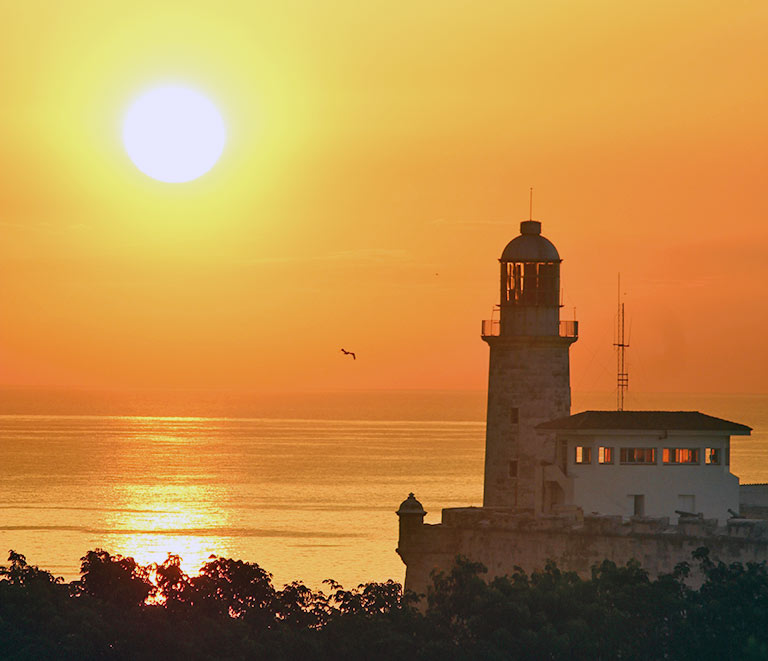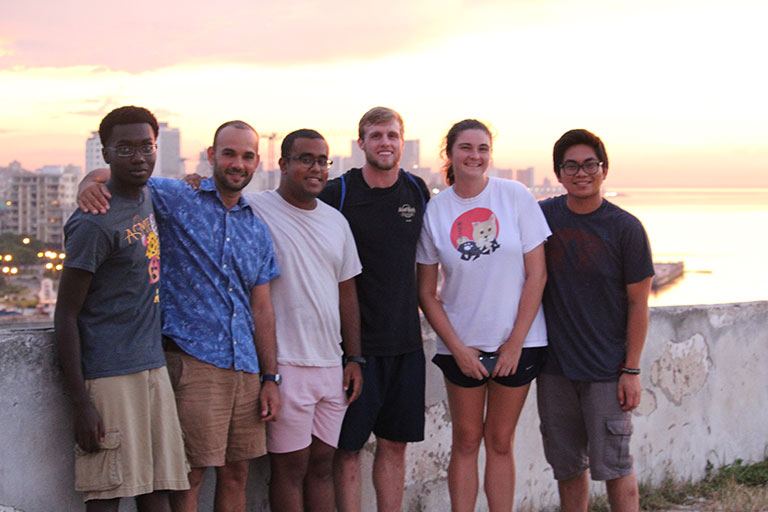Trip Report: Alternative Fall Break in Cuba
The Tickle College of Engineering sponsored the Fall Alternative Break in Havana Cuba, from August 12 – 18, 2017. Participating in the second Global Initiatives trip to Cuba were: Kunal Ashok, senior mechanical engineering major; David Barnes, senior chemical engineering major; Nicole Gonzalez; senior civil engineering major; Caitlyn Harpell, sophomore materials science major; and Roy Tan and Yaw Mensah, sophomore electrical engineering majors. TCE International Coordinator Judith Mallory led the trip, the 17th for Global Initiatives. Globe Aware of Dallas, Texas, coordinated the trip details.
Read about Kunal Ashok’s experience in Cuba »
Read about David Barnes’ experience in Cuba »
Read about Nicole Gonzalez’s experience in Cuba »
Read about Yaw Mensah’s experience in Cuba »
Read about Roy Tan’s experience in Cuba »
The Republic of Cuba is located in the Northern Caribbean Sea, ninety miles south of Florida, where the Caribbean, the Gulf of Mexico, and the Atlantic Ocean meet. The largest island in the Caribbean, Cuba is the second-most populous after Hispaniola, with over 11 million inhabitants. The main exports of Cuba are raw sugar, rum, rolled tobacco, petroleum, and nickel. Cuba’s is a planned economy dominated by state-run enterprises. Housing and transportation costs are low. Cubans receive free education, health care, and food subsidies. Ration books are still used for this purpose. Its three main religions are Catholicism, Atheism, and Santeria, an Afro-Cuban faith similar to that in Haiti. Since 1965, the country has been governed by the Communist Party of Cuba. Culturally, Cuba is considered part of Latin America. It is a multiethnic country whose people, culture, and customs derive from diverse origins, including the aboriginal Taíno and Ciboney peoples, the long period of Spanish colonialism, the introduction of African slaves, and a close relationship with the Soviet Union in the Cold War.
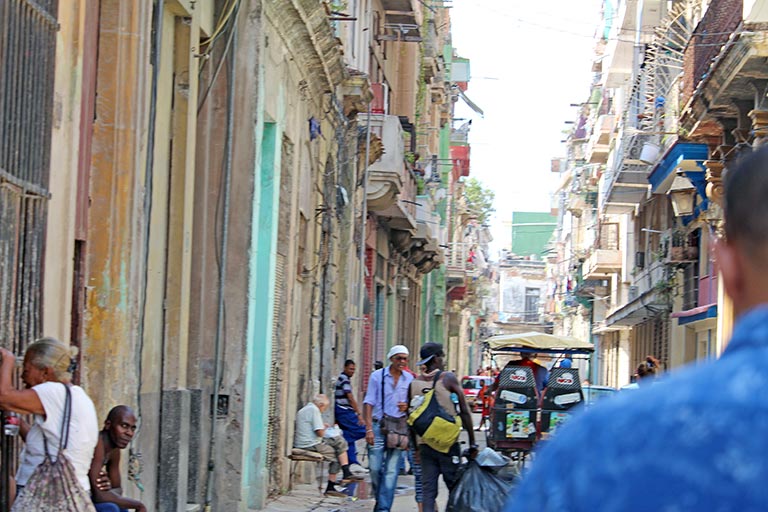
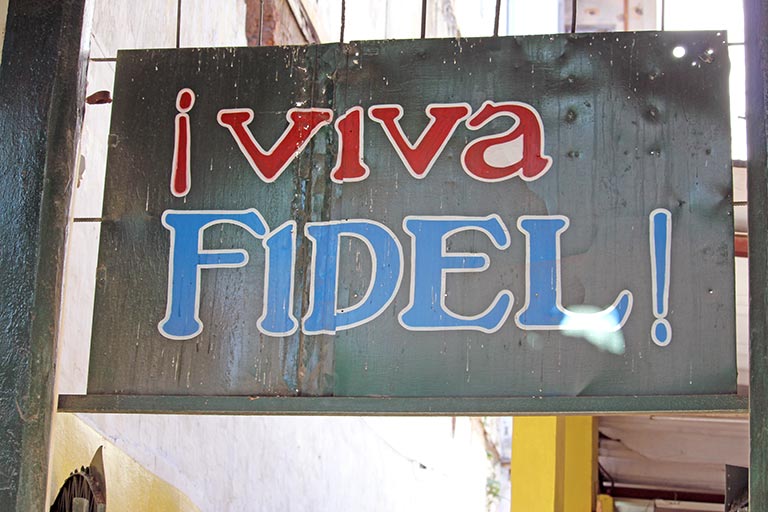
Since the previous Global Initiatives trip to Cuba, US-owned carriers are now allowed to fly directly into the country; this is not only more convenient than going through Mexico first, it came with a significant money savings as well. Andres Gonzalez, the in-country coordinator, collected the group at the Jose Marti airport in Havana and took the visitors to the casa particular, or private home, located in historic Habana Vieja, or “Old Havana” where they would stay for the week. The Cuban government has recently approved the use of private homes for tourist rental. Similarly, they approved the concept of the paladar, which is a private home opened up by the resident to serve meals to the public. The option of operating any independent enterprise in Cuba is taxed at the rate of 20%. The casa particular used by the group was one floor of an old apartment building, close to the place the first group stayed last year, this time on Curazao Street. Along the roads into town is colorful pro-Castro and anti-embargo propaganda on billboards and signs. Cubans refer to the embargo placed upon their country in the 1960s by the United States as “the blockade.”
The first full day was spent on foot, touring main sites in Havana, including the old city, Opera House, the Capitol building, the Ambos Mundo Hotel (where Ernest Hemingway purportedly composed A Farewell to Arms) Plaza Vieja, Plaza de Armas, Plaza del Cristo, a local fruit market, Parque Central, several Santaria shops, and the Bacardi Building, among other attractions. Part of the walking tour took place along the Paseo del Prado, a wide terrazzo walkway which leads through town all the way to the Bay of Havana and the famous Malecon, the road running alongside the sea. Many, many locals were out and about on the streets and in the parks enjoying live music, and a dozen or so artists had work for sale along the Paseo del Prado.
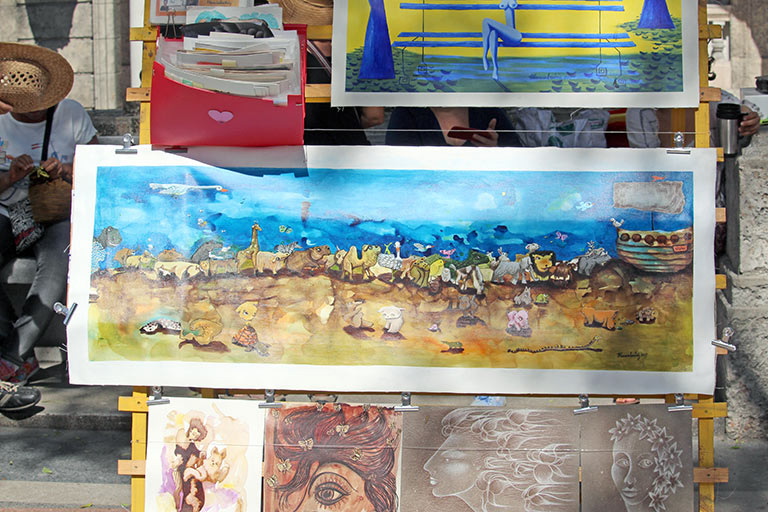
The group had a cooking class at Andres’ home, where they learned how to make Ropa Vieja and tostones, a beef dish and deep-fried plantains, which they got to consume upon the conclusion of the class.
Most of the city is amazingly clean for its size and filled with many styles of architecture; buildings are in various states of repair. Numerous classic cars from the U.S. are on the roads in Havana, operating as taxis, in addition to automobiles from China and Russia. A classic car tour was included on day three and went from Habana Vieja over to Miramar and Vedado, and back through China Town, “the only China Town in the world with no Chinese in it.” Apparently, those residents left shortly after the embargo.
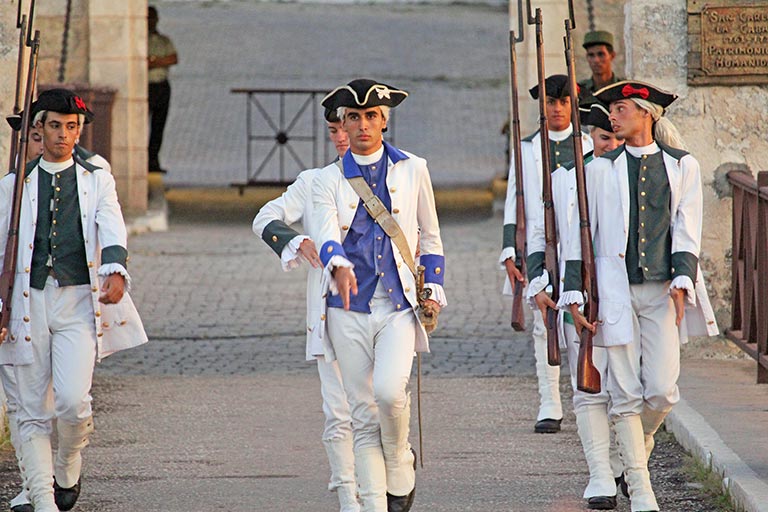
The second evening was spent at the Castillo de San Carlos de la Cabana, the largest fortress in Latin America, dating from the 18th century, which at the time made Havana the most heavily-fortified city in the New World. Intact stone walls surround the installation. There are two drawbridges (now nonfunctioning) and thus two motes. The group observed the nightly canon ceremony, the Cañonazo, which is re-enacted by actual military personnel in period costume. Picture American Revolutionary soldiers in tri-cornered hats and powdered wigs and you are on the right track. The ceremony is elaborate, with lots of shouting (in Spanish, of course) and a drum corps. It is symbolic of times of yore when the gates to the city were closed each night at 9.00 p.m. Although an actual ccannonball is not fired into the bay, the gunpowder they use sounds very similar. The shot can supposedly be heard every night all over Havana at precisely 9.00 p.m. A large contingent of the Ecuadorian Navy was visiting the Castillo, having sailed around South America. Located at the Castillo is the newly-reopened Che Museum, in honor of Argentinian revolutionary Che Guevara, who was instrumental in helping Fidel Castro overthrow the Batista regime. Many artifacts of Che’s life are on display in this tiny museum, including his spy glasses, flak jacket, real and fake passports, and even the small coffin-like box which held his excavated bones from his makeshift burial site in the mountains of Bolivia, after he was killed by the American CIA.
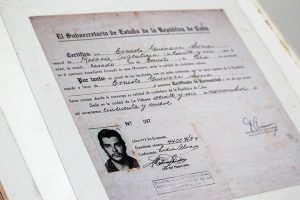
Lots of restoration is happening in Havana, not only by Cubans but by the French and Chinese. Havana’s City Historian, Eusebio Leal Spengler, set up an organization known as Habaguanex in 1994. It serves as a holding company that earns money through tourism and re-invests in a mix of historical preservation and city-wide urban regeneration. This benefits the neighborhood’s 91,000 residents not only by attracting tourists to an area under restoration, but with improved schools, special needs facilities, elder care homes, neighborhood organizations, and historically significant buildings. It is estimated that about 25% of Old Havana has been refurbished due to the efforts of Habaguanex, who runs 20 hotels, four classic forts, and over 30 museums.
The work days were spent in the district of Casa Blanca, accessible by an old, rusty ferry in excellent operating condition. Immediately after exiting the ferry, one may observe an old, operational electric train. The quieter side of Havana, Casa Blanca has some residents working on the promotion of economic development. One attraction they hope to soon complete is a therapeutic center that will offer services to the community as well as tourists. In addition to meditation and yoga, they will offer massage, whole foods, and medicinal herbs, which they are now growing at La Finca Archaeologica Rincon del Cristo. The reference to archaeology in the name refers to fossils found onsite. The group was tasked with continuing the work started last year there by TCE students. This time, the project was to run electrical wiring between the structures at the site. This involved climbing high in trees to string the wire between the “buildings.” The kiosk constructed last year is now operational and outfitted with minimal electricity and a sort of sink; the goal is to have electricity in the outdoor kitchen and the tiny bathrooms which have been only roughed-in so far. The students got to sample coconut water, still in the shell, which had just been chopped open with a machete by one of the locals who worked alongside the group on the project. The group brought tools for the project, as they are expensive and difficult to obtain in Cuba. They were donated for future building projects.
While touring the site, the group saw the sculpture El Cristo de la Habana, The Christ of Havana, a colossal sculpture representing the Sacred Heart of Jesus, and is the work of Cuban sculptor Jilma Madera. The statue was made of marble from Carrara, Italy, and is about 20 meters high, resting on a base of three meters in which its creator buried diverse objects of the time. Its approximate weight is 320 tons. The statue consists of 67 pieces that were brought from Italy, since it was sculpted in Rome, and blessed there by Pope Pius XII . It is one of four white Christ statues in the world, similar to the much larger Cristo Redentor statue in Rio de Janeiro, Brazil. Inaugurated on December 24, 1958; just fifteen days later, Fidel Castro entered Havana during the Cuban Revolution.
Another attraction the group got to visit was the Camera Obscura. Leonardo da Vinci first detailed the description of the camera obscura in his “Atlantic Codex” in 1490, but the concept dates from the 5th Century B.C. It was a gift to Havana from Spain, and the only one of its kind in Latin America. A camera obscura (Latin for “dark chamber”) is an optical device that led to photography and the photographic camera. The device consists of a box or room with a hole in one side. Light from an external scene passes through the hole and strikes a surface inside, where it is reproduced, inverted (thus upside-down), but with color and perspective preserved. In the case of the Camera Obscura in Havana, one may view surroundings in a 360-degree perspective in real time. The next stop was the Maqueta de la Habana, a 1:500 scale miniature depiction of the city. This was a massive family effort which took several years to complete. The buildings are lighted in order that one may observe how the city looks at night.
A most interesting engineering marvel was observed by car several times on the trip. In the late fifties, Cuban dictator Fulgencio Batista planned to expand the city to the East. A new interconnection between Old City and the Eastern side across the Bay of Havana was needed, so the traffic tunnel under the Havana Bay was built by the French company, Societé de Grand Travaux de Marseille between 1957and 1958. The tunnel begins at the Paseo de Prado in Old Havana, is 733m long and 12m below ground level. It is known as the Rio Almendares Tunnel, since the Rio Almendares, or the Almendares River above it separates the residential Miramar district from the neighboring Vedado district.
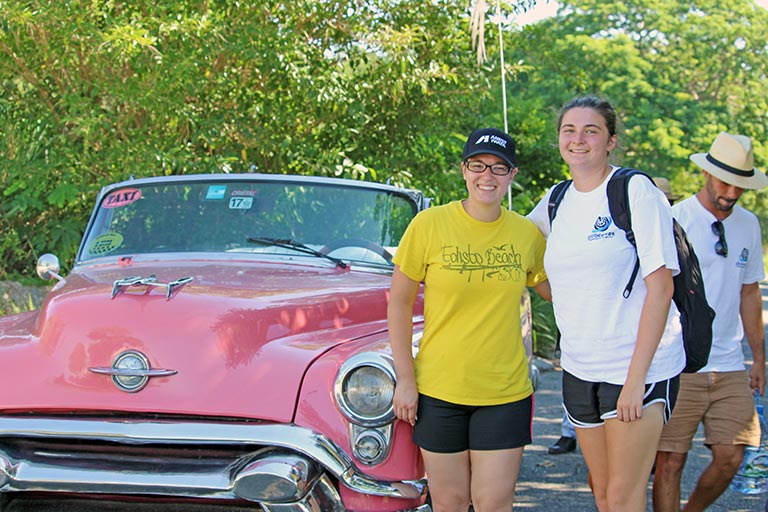
The students got to experience the local crafts market, which they reached via bicycle taxi. The idea for the bici-taxi came from the Chinese rickshaw. The base is a bicycle and a semi-covered double seat is attached in the back, where passengers can ride. Some of the bici-taxis had music, bumper stickers, air horns and hood ornaments from classic cars. The market is in a huge old warehouse on the waterfront of the Bay of Havana. Many booths and merchants are on hand, offering items such as tee shirts, flags, bags, back packs, jewelry, craft items, and an immense amount of original art.
Another interesting cultural stop was at the Museo Nacional de Bellas Artes de La Habana, or the Fine Arts Museum, exhibiting Cuban art collections from Colonial times up to the contemporary period. The museum is dedicated exclusively to housing Cuba Art collections. Spanning the 17th and 19th centuries, the museum has rooms devoted to landscape, religious subjects, and the Costumbrismo narrative scenes of Cuban life. In contrast, there is another gallery devoted to the 1970s, which is marked by a preponderance of Hyperrealism and the latest generation of Cuban artists whose works all reflect the strong symbolic imagery that has been prevalent in recent decades. A modernist sculpture by noted Cuban artist Rita Lonja stands outside the main entrance.
Yet another fascinating attraction seen by the group was the Museo de la Revolución, or Museum of the Revolution, which commemorates a major historical event in Cuba. It is a museum housed in what was the Presidential Palace of all Cuban presidents from Mario García Menocal to Fulgencio Batista, and was the Presidential Palace until 1959. The museum’s Cuban history exhibits are largely devoted to the period of the revolutionary period of the 1950s and to the country’s post-1959 history. Portions of the museum are also devoted to pre-revolutionary Cuba, including its War of Independence waged against Spain.
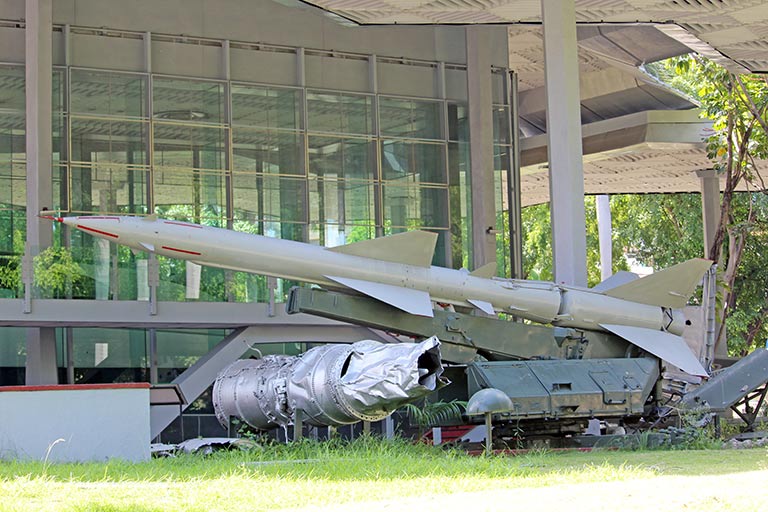
Behind the building lies the Granma Memorial, a large glass enclosure which houses the Granma, the yacht which took Che Guevara, Fidel Castro, and his brother Raúl Castro along with 78 other revolutionaries from Mexico to Cuba for the attempted revolution of 1956. The 60-foot (18 m) diesel-powered cabin cruiser was built in 1943 and designed to accommodate 12 people. Around the Granma an SA-2 Guideline surface-to-air missile of the type that shot down a U.S. Lockheed U-2 spyplane during the Cuban Missile Crisis, and the engine of the U-2 airplane is displayed. There are also various vehicles and tanks used in the revolution available for viewing. Near the museum is located an SU-100, a Soviet tank destroyer. The tank upon which Che Guevara, Fidel Castro, and Camino Cienfuegos rode through Havana to celebrate the Revolution is parked on the lawn in front of the museum. Many artifacts are in the museum including clothing, photographs, uniforms, medical equipment, letters, weapons, paintings, and even a diorama featuring Che and Fidel in the mountains. Bullet holes remain in the walls of the stairway, from the time the Palace was stormed by revolutionaries.
The Cuban people demonstrated a sense of warmth, friendliness, and determination to live life to the fullest. At any hour, people could be found on the streets talking, playing music, and enjoying each other’s company.
After seven days in Cuba, the group came away with an appreciation for and perspective of the gastronomy, culture, people, history, politics, and economy of this country only recently opened to visits by United States Citizens.
